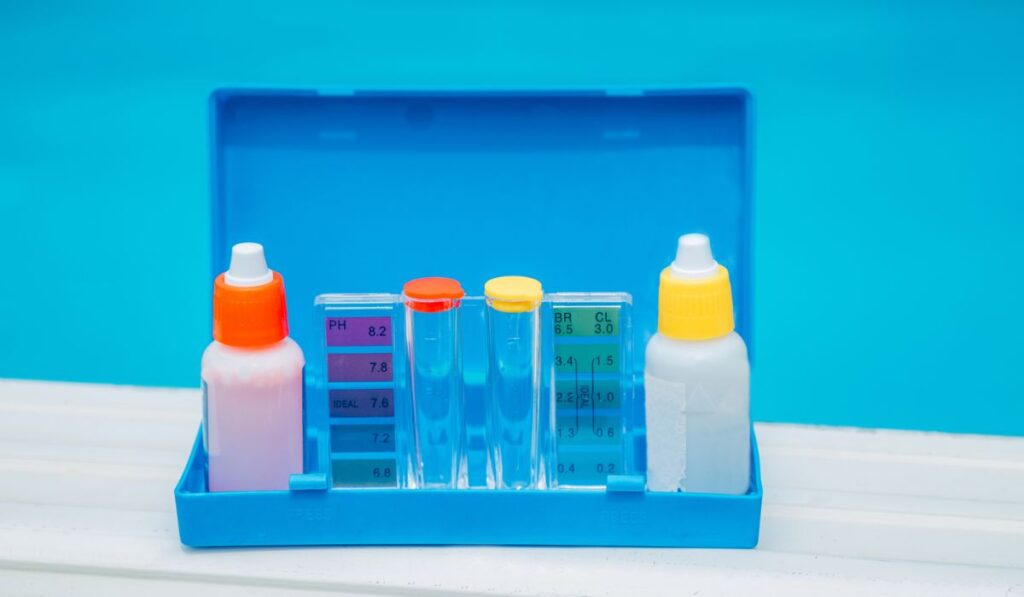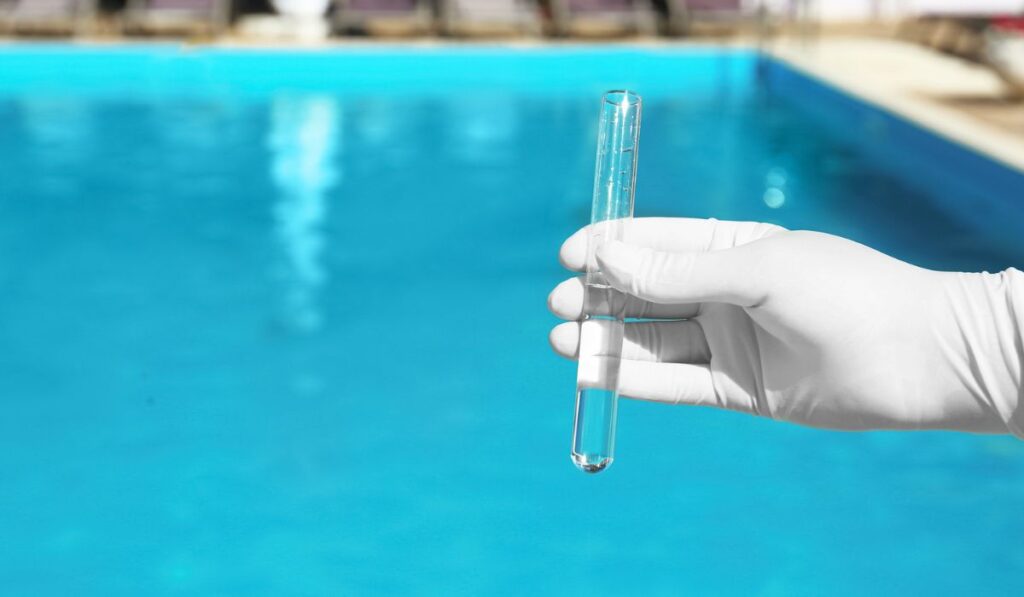When added properly, algaecide can be extremely effective in fighting black, mustard, and green algae in your pool. The liquid substance is directly added to the surface of your pool but can have negative side effects for both the swimmers and the water if you put in too much.
Putting too much algaecide in your pool can result in algaecide foam and skin irritation. The easiest way to fix the issue is to just wait for the algaecide to dissipate naturally. You can also speed up the process by removing the foam with a skimmer and adding antifoam chemicals to the water.
Adding too much algaecide into your swimming pool is an honest mistake to make when reacting to algae growth in your pool. Luckily, it’s also extremely easy to both fix and avoid. Let’s look at how you can overdo algaecide in your pool, what you should do if you add in too much, and how often you should actually add it to the water.
Can You Add Too Much Algaecide to a Pool?

Yes, you can overdo it when adding algaecides like this one (on Amazon) to your pool, and it’s actually pretty easy to do if you’re not careful. Most pool owners include algaecide in their regular pool maintenance to prevent the growth of algae in their swimming pool.
And while you can also use an algaecide to treat algae, it’s simply more effective as a preventative chemical. Adding too much algaecide has a few negative effects as well, such as:
Foam
Adding more than the required amount of algaecide can result in foamy pool water. If you add too much algaecide to your pool, you’ll see small bubbles being pushed out of the return jets and back into the water.
However, keep in mind that bubbles and foam are also associated with air in the pool lines, so make sure you don’t confuse the two. The foam and bubbles caused by too much algaecide are usually much smaller in size, so try to determine the actual cause of the problem before moving on to the fix.
Skin Irritations
If you add too much algaecide in your pool, then everyone in the water will likely experience skin and eye irritations. The more you add excessive algaecide to your pool, the more severe the skin irritations will be.
It’s important to note that other chemical imbalances can also cause eye irritation, such as too much chlorine and unstable alkalinity or pH levels. So, it’s best to test the water before you start removing the algaecide from the water.
What Do I Do If I Put Too Much Algaecide in My Pool?
The best way to get rid of all the extra algaecide in your pool water is to just wait it out. After a couple of days, all the foam and bubbles caused by the extreme algaecide levels will break down on their own.
It normally takes about two to three days for the algaecide to dissipate naturally, but the entire process could take more than a week as well.
However, for many pool owners, waiting for such a long time is not really a feasible solution, especially if the situation happens during peak swimming season. Luckily, you can speed up the process by using a net to skim and remove as much of the foam that’s floating on the surface of the water as possible.
Alternatively, you can also drain part of your pool and refill it, which will further dilute the algaecide. You can then start over with pH balancing and shock treatments to bring your pool back to its balanced state.
While this solution requires much more time and effort, it will enable you to open your pool for swimming much more quickly. It’s also advisable to run your filter for about two hours after adding the chemical to ensure proper circulation and distribution of algaecide in the water.
If you want all the extra algaecide to be gone even quicker, you can add chlorine or any other anti-foam chemical to your pool.
Preventing Algaecide Foam
The easiest way to prevent algaecide foam from contaminating your pool in the first place is to only add algaecide when there are actually algae in the water. While the chemical can help prevent the growth of algae, it’s important to note that it will just keep building up in your pool if it has nothing to work on.
You can also prevent algaecide foam by using a non-copper and non-foaming algaecide, like this one from HTH (on Amazon).
How Often Should You Add Algaecide to Your Pool?
The best practice is to add algaecide after every shock treatment so that the chemical has a better chance to work with chlorine as it makes its way around the pool. However, make sure you shock the pool first, wait for the chlorine levels to drop back to normal, and then add the right amount of algaecide all around the pool.
Remember to turn on the pump, so the algaecide circulates properly. And make sure you take all the necessary precautions, as using algaecide and pool shock together can result in bad chemical reactions if they’re not handled properly.
It’s crucial to add only the correct amount of algaecide in your pool as well. The correct dosage will be determined by the total gallons of water in your pool. You can use an online pool calculator to calculate the right amount of algaecide and measure exactly what your pool’s pH levels should be after adding the chemical.
Along with adding algaecide after shocking the water, you should also add the chemical when you’re closing down the pool for the year. Dark, humid weather promotes algae growth, so adding algaecide will prevent you from getting any surprises when you open up the pool again.
How Long After Algaecide Can You Shock?

It’s best to wait at least 24 hours after adding algaecide to shock the pool. Make sure you also check your pool’s total chlorine and free chlorine levels after shocking because they could increase a lot if you don’t wait long enough after adding algaecide.
If the chlorine levels exceed the normal range, you’ll have to drain around 25% of the water to bring your pool back to its balanced state.
